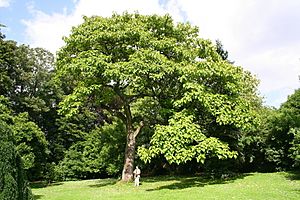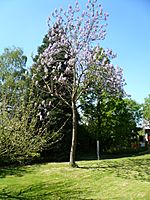Princess tree facts for kids
Quick facts for kids Princess tree |
|
|---|---|
 |
|
| Scientific classification | |
| Genus: |
Paulownia
|
| Species: |
tomentosa
|
Paulownia tomentosa, common names princess tree, empress tree, or foxglove-tree, is a deciduous tree in the family Paulowniaceae, native to central and western China. It is an extremely fast-growing tree with seeds that disperse readily, and is a persistent exotic introduced species in North America, where it has undergone naturalisation in large areas of the Eastern US. P. tomentosa has also been introduced to Western and Central Europe, and is establishing itself as a naturalised species there as well.
Contents
Etymology
The generic name Paulownia honors Anna Pavlovna of Russia. The specific epithet tomentosa is a Latin word meaning ‘covered in hairs’.
Description
This tree grows 10–25 m (33–82 ft) tall, with large heart-shaped to five-lobed leaves 15–40 cm (6–16 in) across, arranged in opposite pairs on the stem. On young growth, the leaves may be in whorls of three and be much bigger than the leaves on more mature growth. The leaves can be mistaken for those of the catalpa.
The very fragrant flowers are produced before the leaves in early spring, on panicles 10–30 cm long, with a tubular purple corolla 4–6 cm long resembling a foxglove flower. The fruit is a dry egg-shaped capsule 3–4 cm long, containing numerous tiny seeds. The seeds are winged and disperse by wind and water. Pollarded trees do not produce flowers, as these form only on mature wood.
Paulownia tomentosa requires full sun for proper growth. It is tolerant of pollution and can tolerate many soil types. It can also grow from small cracks in pavements and walls. Paulownia can survive wildfire because the roots can regenerate new, very fast-growing stems.
Uses
Paulownia tomentosa is cultivated as an ornamental tree in parks and gardens. It has gained the Royal Horticultural Society's Award of Garden Merit.
Because of its tolerance and flexibility, Paulownia functions ecologically as a pioneer plant. Its nitrogen-rich leaves provide good fodder and its roots prevent soil erosion. Eventually, Paulownia is succeeded by taller trees that shade it and in whose shade it cannot thrive.
An acre of empress trees can absorb 103 metric tons of carbon dioxide a year. Once the trees reach maturity, farmers harvest their wood for use in houses or musical instruments.
The characteristic large size of the young growth is exploited by gardeners: by pollarding the tree and ensuring there is vigorous new growth every year, massive leaves are produced (up to 23in/60 cm across). These are popular in the modern style of gardening which uses large-foliaged and "architectural" plants.
In Japan, the tree is planted at the birth of a girl. The fast-growing tree matures when she does. When she is eligible for marriage the tree is cut down and carved into wooden articles for her dowry. Carving the wood of Paulownia is an art form in Japan. In legend, it is said that the phoenix will land only on this tree, and only when a good ruler is in power. Several Asian string instruments are made from P. tomentosa, including the Japanese koto and Korean gayageum zithers.
The soft, lightweight seeds were commonly used as a packing material by Chinese porcelain exporters in the 19th century, before the development of polystyrene packaging. Packing cases would often leak or burst open in transit and scatter the seeds along rail tracks. The magnitude of the numbers of seeds used for packaging, together with seeds deliberately planted for ornament, has allowed the species to be viewed as an invasive species in areas where the climate is suitable for its growth, notably Japan and the eastern United States.
Composition
Some geranylflavonoids can be found in P. tomentosa.
Verbascoside can also be produced in hairy roots cultures of P. tomentosa.
Pictures
See also
 In Spanish: Paulownia tomentosa para niños
In Spanish: Paulownia tomentosa para niños











